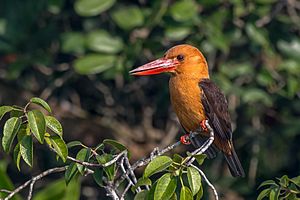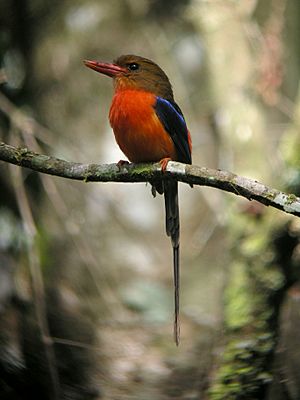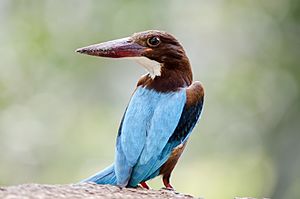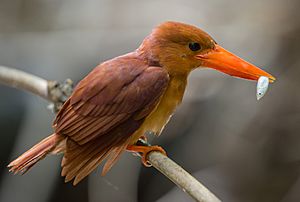Tree kingfisher facts for kids
Quick facts for kids Tree kingfisher |
|
|---|---|
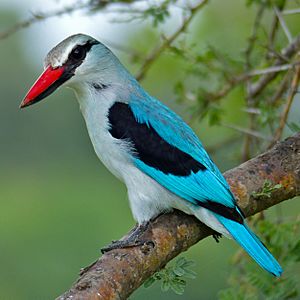 |
|
| Woodland kingfisher (Halcyon senegalensis) |
|
| Scientific classification |
|
| Kingdom: | Animalia |
| Phylum: | Chordata |
| Class: | Aves |
| Order: | Coraciiformes |
| Family: | Alcedinidae |
| Subfamily: | Halcyoninae Vigors, 1825 |
| Genera | |
| Family Tree of Tree Kingfishers | |||||||||||||||||||||||||||||||||||||||||||||||||||||||||
|
|||||||||||||||||||||||||||||||||||||||||||||||||||||||||
| This diagram shows how different groups of tree kingfishers are related. It's based on a science study from 2017. Some groups, like Dacelo and Actenoides, are not "monophyletic," meaning they don't include all their descendants. For example, the shovel-billed kookaburra (Clytoceyx) is actually part of the Dacelo group, and the glittering kingfisher (Caridonax) is part of Actenoides. |
The tree kingfishers, also known as wood kingfishers, belong to the subfamily Halcyoninae. They are the largest group within the kingfisher family, with about 70 different species. These birds are found in 12 different genera, including several types of kookaburras. Tree kingfishers likely first appeared in Indochina and Maritime Southeast Asia. From there, they spread to many parts of the world. You can find them across Asia and Australasia, and also in Africa and on islands in the Pacific and Indian Oceans. They live in many different places, from tropical rainforests to open woodlands.
Tree kingfishers are compact birds with large heads and short tails. They have long, pointed bills. Like other birds in their order, Coraciiformes, they have very bright colors. Most tree kingfishers stay with one partner and defend their territory. They build their nests in holes in trees or in termite nests. Both parents help to incubate the eggs and feed their young. Even though some tree kingfishers live near water, they don't mainly eat fish. Most species hunt by diving from a perch. They mostly catch slow-moving insects or small animals.
Contents
About Tree Kingfishers
The group of tree kingfishers is often called Daceloninae. However, the name Halcyoninae was given earlier in 1825 by Nicholas Aylward Vigors, so it is the correct name to use.
The Halcyoninae subfamily is one of three main groups in the kingfisher family, Alcedinidae. The other two groups are river kingfishers and water kingfishers. The tree kingfisher group includes about 70 species, divided into 12 genera. A scientific study in 2017 showed that some groups, like Dacelo and Actenoides, are not as neatly separated as once thought. For example, the shovel-billed kookaburra (Clytoceyx) is actually part of the Dacelo group. Also, the glittering kingfisher (Caridonax) belongs within the Actenoides group.
Types of Tree Kingfishers
Here are some of the different groups, or genera, of tree kingfishers:
- Genus Actenoides
-
- Green-backed kingfisher
- Scaly-breasted kingfisher
- Moustached kingfisher
- Spotted wood kingfisher
- Hombron's kingfisher
- Rufous-collared kingfisher
- Genus Melidora
- Genus Lacedo
- Genus Tanysiptera, known as paradise kingfishers
-
- Common paradise kingfisher
- Kofiau paradise kingfisher
- Biak paradise kingfisher
- Numfor paradise kingfisher
- Little paradise kingfisher
- Buff-breasted paradise kingfisher
- Black-capped paradise kingfisher
- Red-breasted paradise kingfisher
- Brown-headed paradise kingfisher
- Genus Cittura
-
- Lilac kingfisher
- Genus Clytoceyx
- Genus Dacelo, known as kookaburras
-
- Laughing kookaburra
- Blue-winged kookaburra
- Spangled kookaburra
- Rufous-bellied kookaburra
- Genus Caridonax
-
- Glittering kingfisher
- Genus Pelargopsis
-
- Stork-billed kingfisher
- Great-billed kingfisher
- Brown-winged kingfisher
- Genus Halcyon
- Genus Todirhamphus
-
- Blue-black kingfisher
- Winchell's kingfisher
- Blue-and-white kingfisher
- Lazuli kingfisher
- Forest kingfisher
- White-mantled kingfisher
- Ultramarine kingfisher
- Vanuatu kingfisher
- Sombre kingfisher
- Collared kingfisher
- Torresian kingfisher
- Islet kingfisher
- Mariana kingfisher
- Melanesian kingfisher
- Pacific kingfisher
- Talaud kingfisher
- Guam kingfisher
- Rusty-capped kingfisher
- Pohnpei kingfisher
- Beach kingfisher
- Sacred kingfisher
- Flat-billed kingfisher
- Cinnamon-banded kingfisher
- Chattering kingfisher
- Mewing kingfisher
- Society kingfisher
- Mangareva kingfisher
- Niau kingfisher
- Marquesan kingfisher
- Red-backed kingfisher
- Genus Syma
Appearance of Tree Kingfishers
Kingfishers are known for their short tails, large heads, and compact bodies. They all have long, pointed bills. Like other birds in the Coraciiformes group, they are very colorful. Tree kingfishers are medium to large birds. Most look like typical kingfishers. However, the shovel-billed kookaburra has a huge, cone-shaped bill. The Tanysiptera paradise kingfishers have long, streaming tail feathers. Some species, especially the kookaburras, show sexual dimorphism. This means males and females look different from each other.
Where Tree Kingfishers Live
Most tree kingfishers live in warm parts of the world. You can find them in Africa, southern and southeast Asia, and Australasia. There are no tree kingfishers in North or South America. Scientists believe this bird family first came from tropical Australasia. This area still has the most species.
Tree kingfishers live in many different places. These range from thick tropical rainforests to open woodlands and thorny bush areas. Many species do not need to be close to water. You can even find them in dry areas of Australia and Africa.
Reproduction and Life Cycle
Tree kingfishers usually have one partner and defend their nesting area. However, some species, like three types of kookaburras, have a special system. Younger birds from earlier broods help their parents raise new chicks. Nests are usually in tree holes. These can be natural holes, old woodpecker nests, or holes the kingfishers dig themselves in soft or rotting wood. Several species also dig holes in termite nests. The birds do not add any nesting material. However, leaves and other bits can build up over the years.
Both parents take turns incubating the eggs and feeding the chicks. The eggs are laid one day apart. This means the chicks hatch at different times. If there isn't enough food, the older, larger chicks get fed first. When they hatch, the chicks are naked, blind, and cannot move much. They stand on their heels, which is different from adult kingfishers.
What Tree Kingfishers Eat
While some tree kingfishers, like the black-capped kingfisher, live near water, none of them are experts at catching fish. Most species hunt by waiting quietly on a perch. Then, they dive down to catch their prey. They mainly eat slow-moving insects or small animals. The shovel-billed kookaburra digs through fallen leaves to find worms and other food. The Vanuatu kingfisher eats only insects and spiders. Several other species in the western Pacific also mainly eat insects and catch them while flying. Like other kingfisher families, species that eat insects often have flat, red bills. This helps them catch insects more easily.
See also
 In Spanish: Halciónidos para niños
In Spanish: Halciónidos para niños


